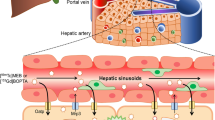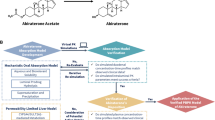Abstract
Purpose
Transport of the hepatobiliary scintigraphy agent Tc-99m mebrofenin (MEB) was characterized and simulation studies were conducted to examine the effects of altered hepatic transport on MEB pharmacokinetics in humans.
Methods
MEB transport was investigated in Xenopus laevis oocytes expressing OATP1B1 or OATP1B3, and in membrane vesicles prepared from HEK293 cells transfected with MRP2 or MRP3. A pharmacokinetic model was developed based on blood, urine and bile concentration-time profiles obtained in healthy humans, and the effect of changes in hepatic uptake and/or excretion associated with disease states (hyperbilirubinemia and cholestasis) on MEB disposition was simulated.
Results
MEB (80 pM) transport by OATP1B1 and OATP1B3 was inhibited by rifampicin (50 μM) to 10% and 4% of control, respectively. MEB (0.4 nM) transport by MRP2 was inhibited to 12% of control by MK571 (50 μM); MRP3-mediated transport was inhibited to 5% of control by estradiol-17-beta-glucuronide (100 μM). A two-compartment model described MEB (2.5 mCi) systemic disposition in humans (systemic clearance = 16.2 ± 2.7 ml min−1 kg−1); biliary excretion was the predominant route of hepatic elimination (efflux rate constants ratio canalicular/sinusoidal = 3.4 ± 0.8). Based on simulations, altered hepatic transport markedly influenced MEB systemic and hepatic exposure.
Conclusions
MEB may be a useful probe to assess how altered hepatic function at the transport level modulates hepatobiliary drug disposition.






Similar content being viewed by others
Abbreviations
- EF:
-
gallbladder ejection fraction
- E217βG:
-
estradiol 17-β-d-glucuronide
- GB:
-
gamma counts over gallbladder region
- HEK293:
-
human embryonic kidney cells
- HIDA:
-
hepatobiliary imino diacetic acid
- MEB:
-
Tc-99m mebrofenin
- MRP:
-
multidrug resistance-associated protein
- OATP:
-
organic anion transporting polypeptide
- OR-2:
-
oocyte Ringer’s 2 buffer
- Tc-99m:
-
99mtechnetium
- TR− :
-
Mrp2 transport-deficient Wistar rat
References
S. Krishnamurthy, and G. T. Krishnamurthy. Technetium-99m-iminodiacetic acid organic anions: review of biokinetics and clinical application in hepatology. Hepatology. 9:139–153 (1989).
E. Gencoglu, H. Karakayali, G. Moray, A. Aktas, and M. Haberal. Evaluation of pediatric liver transplant recipients using quantitative hepatobiliary scintigraphy. Transplant Proc. 34:2160–2162 (2002).
M. Koruk, S. Ozkilic, M. C. Savas, Z. Celen, A. Kadayifci, and C. Ozkilic. Evaluation of hepatic functions and biliary dynamics in patients with liver cirrhosis by quantitative scintigraphy. Hepatogastroenterology. 50:1803–1805 (2003).
Y. Bujanover, S. Bar-Meir, I. Hayman, and J. Baron. 99mTc-HIDA cholescintigraphy in children with Dubin–Johnson syndrome. J. Pediatr. Gastroenterol. Nutr. 2:311–312 (1983).
T. Pinos, J. M. Constansa, A. Palacin, and C. Figueras. A new diagnostic approach to the Dubin–Johnson syndrome. Am. J. Gastroenterol. 85:91–93 (1990).
A. M. Peters, M. J. Myers, S. Mohammadtaghi, M. Mubashar, and R. T. Mathie. Bidirectional transport of iminodiacetic organic anion analogues between plasma and hepatocyte. Eur. J. Nucl. Med. 25:766–773 (1998).
N. H. Hendrikse, F. Kuipers, C. Meijer, R. Havinga, C. M. Bijleveld, W. T. van der Graaf, W. Vaalburg, and E. G. de Vries. In vivo imaging of hepatobiliary transport function mediated by multidrug resistance associated protein and P-glycoprotein. Cancer Chemother. Pharmacol. 54:131–138 (2004).
S. Araikum, T. Mdaka, J. D. Esser, and M. Zuckerman. Hepatobiliary kinetics of technetium-99m-IDA analogs: quantification by linear systems theory. J. Nucl. Med. 37:1323–1330 (1996).
G. Ghibellini, B. M. Johnson, R. J. Kowalsky, W. D. Heizer, and K. L. R. Brouwer. A novel method for the determination of biliary clearance in humans. AAPS J. 6:e33 (2004).
J. Kartenbeck, U. Leuschner, R. Mayer, and D. Keppler. Absence of the canalicular isoform of the MRP gene-encoded conjugate export pump from the hepatocytes in Dubin–Johnson syndrome. Hepatology. 23:1061–1066 (1996).
S. Toh, M. Wada, T. Uchiumi, A. Inokuchi, Y. Makino, Y. Horie, Y. Adachi, S. Sakisaka, and M. Kuwano. Genomic structure of the canalicular multispecific organic anion-transporter gene (MRP2/cMOAT) and mutations in the ATP-binding-cassette region in Dubin–Johnson syndrome. Am. J. Hum. Genet. 64:739–746 (1999).
H. Tsujii, J. Konig, D. Rost, B. Stockel, U. Leuschner, and D. Keppler. Exon-intron organization of the human multidrug-resistance protein 2 (MRP2) gene mutated in Dubin–Johnson syndrome. Gastroenterology. 117:653–660 (1999).
C. C. Paulusma, M. Kool, P. J. Bosma, G. L. Scheffer, F. ter Borg, R. J. Scheper, G. N. Tytgat, P. Borst, F. Baas, and R. P. Oude Elferink. A mutation in the human canalicular multispecific organic anion transporter gene causes the Dubin–Johnson syndrome. Hepatology. 25:1539–1542 (1997).
S. Kajihara, A. Hisatomi, T. Mizuta, T. Hara, I. Ozaki, I. Wada, and K. Yamamoto. A splice mutation in the human canalicular multispecific organic anion transporter gene causes Dubin–Johnson syndrome. Biochem. Biophys. Res. Commun. 253:454–457 (1998).
V. Keitel, A. T. Nies, M. Brom, J. Hummel-Eisenbeiss, H. Spring, and D. Keppler. A common Dubin–Johnson syndrome mutation impairs protein maturation and transport activity of MRP2 (ABCC2). Am. J. Physiol. Gastrointest. Liver Physiol. 284:G165–G174 (2003).
J. Konig, D. Rost, Y. Cui, and D. Keppler. Characterization of the human multidrug resistance protein isoform MRP3 localized to the basolateral hepatocyte membrane. Hepatology. 29:1156–1163 (1999).
B. M. Johnson, P. Zhang, J. D. Schuetz, and K. L. R. Brouwer. Characterization of transport protein expression in multidrug resistance-associated protein (mrp) 2-deficient rats. Drug Metab. Dispos. 34:556–562 (2006).
M. G. Donner, and D. Keppler. Up-regulation of basolateral multidrug resistance protein 3 (Mrp3) in cholestatic rat liver. Hepatology. 34:351–359 (2001).
A. Guhlmann, K. Krauss, F. Oberdorfer, T. Siegel, P. H. Scheuber, J. Muller, B. Csuk-Glanzer, S. Ziegler, H. Ostertag, and D. Keppler. Noninvasive assessment of hepatobiliary and renal elimination of cysteinyl leukotrienes by positron emission tomography. Hepatology. 21:1568–1575 (1995).
H. Okuda, R. Nunes, S. Vallabhajosula, A. Strashun, S. J. Goldsmith, and P. D. Berk. Studies of the hepatocellular uptake of the hepatobiliary scintiscanning agent 99mTc-DISIDA. J. Hepatol. 3:251–259 (1986).
Choletec. Kit for the Preparation of Technetium Tc 99m Mebrofenin. Bracco Diagnostic, Inc., Princeton (NJ).
Y. Cui, J. Konig, I. Leier, U. Buchholz, and D. Keppler. Hepatic uptake of bilirubin and its conjugates by the human organic anion transporter SLC21A6. J. Biol. Chem. 276:9626–9630 (2001).
R. J. Kowalsky, and S. W. Falen. Radiopharmaceuticals in Nuclear Pharmacy and Nuclear Medicine. American Pharmacists Association, Washington, D.C., 2004.
D. A. Bow, J. L. Perry, J. D. Simon, and J. B. Pritchard. The impact of plasma protein binding on the renal transport of organic anions. J. Pharmacol. Exp. Ther. 316:349–355 (2005).
K. Ito, C. J. Oleschuk, C. Westlake, M. Z. Vasa, R. G. Deeley, and S. P. Cole. Mutation of Trp1254 in the multispecific organic anion transporter, multidrug resistance protein 2 (MRP2) (ABCC2), alters substrate specificity and results in loss of methotrexate transport activity. J. Biol. Chem. 276:38108–38114 (2001).
C. J. Oleschuk, R. G. Deeley, and S. P. Cole. Substitution of Trp1242 of TM17 alters substrate specificity of human multidrug resistance protein 3. Am. J. Physiol. Gastrointest. Liver Physiol. 284:G280–G289 (2003).
E. M. Leslie, Q. Mao, C. J. Oleschuk, R. G. Deeley, and S. P. Cole. Modulation of multidrug resistance protein 1 (MRP1/ABCC1) transport and atpase activities by interaction with dietary flavonoids. Mol. Pharmacol. 59:1171–1180 (2001).
A. Geier, M. Wagner, C. G. Dietrich, and M. Trauner. Principles of hepatic organic anion transporter regulation during cholestasis, inflammation and liver regeneration. Biochim. Biophys. Acta. 1773:283–308 (2007).
S. R. Vavricka, J. Van Montfoort, H. R. Ha, P. J. Meier, and K. Fattinger. Interactions of rifamycin SV and rifampicin with organic anion uptake systems of human liver. Hepatology. 36:164–172 (2002).
B. Hagenbuch, and P. J. Meier. Organic anion transporting polypeptides of the OATP/ SLC21 family: phylogenetic classification as OATP/ SLCO superfamily, new nomenclature and molecular/functional properties. Pflugers Arch. 447:653–665 (2004).
S. N. Barnes, L. M. Aleksunes, L. Augustine, G. L. Scheffer, M. J. Goedken, A. B. Jakowski, I. M. Pruimboom-Brees, N. J. Cherrington, and J. E. Manautou. Induction of hepatobiliary efflux transporters in acetaminophen-induced acute liver failure cases. Drug Metab. Dispos. 35:1963–1969 (2007).
P. Chandra, and K. L. R. Brouwer. The complexities of hepatic drug transport: current knowledge and emerging concepts. Pharm. Res. 21:719–735 (2004).
J. Konig, A. T. Nies, Y. Cui, I. Leier, and D. Keppler. Conjugate export pumps of the multidrug resistance protein (MRP) family: localization, substrate specificity, and MRP2-mediated drug resistance. Biochim. Biophys. Acta. 1461:377–394 (1999).
B. Stockel, J. Konig, A. T. Nies, Y. Cui, M. Brom, and D. Keppler. Characterization of the 5’-flanking region of the human multidrug resistance protein 2 (MRP2) gene and its regulation in comparison with the multidrug resistance protein 3 (MRP3) gene. Eur. J. Biochem. 267:1347–1358 (2000).
Acknowledgements
This work was supported by National Institutes of Health grant R01 GM41935 and grant RR00046 from the GCRC program of the Division of Research Resources. Giulia Ghibellini was the recipient of an American Foundation for Pharmaceutical Education Predoctoral Fellowship, Elaine M. Leslie was the recipient of a Postdoctoral Fellowship from the Canadian Institutes of Health Research (CIHR).
Drs. Richard Kowalsky, Daniel Bow, Joe Polli and Brendan Johnson are gratefully acknowledged for their expertise and help in the execution of the in vitro and in vivo studies. Drs. Susan P.C. Cole and Roger G. Deeley (Queen’s University) kindly provided the MRP2 and MRP3 vectors.
Author information
Authors and Affiliations
Corresponding author
Rights and permissions
About this article
Cite this article
Ghibellini, G., Leslie, E.M., Pollack, G.M. et al. Use of Tc-99m Mebrofenin as a Clinical Probe to Assess Altered Hepatobiliary Transport: Integration of In Vitro, Pharmacokinetic Modeling, and Simulation Studies. Pharm Res 25, 1851–1860 (2008). https://doi.org/10.1007/s11095-008-9597-0
Received:
Accepted:
Published:
Issue Date:
DOI: https://doi.org/10.1007/s11095-008-9597-0




